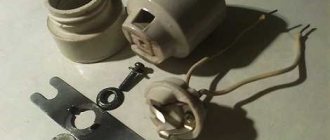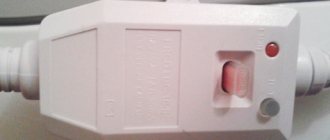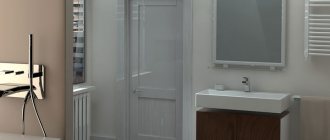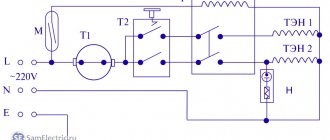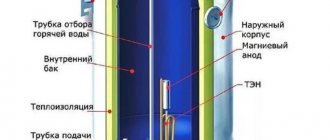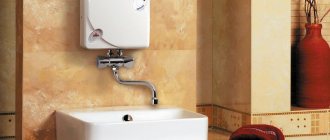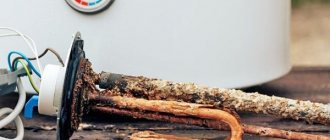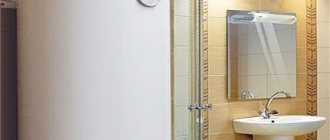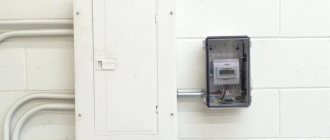How does an RCD work and why is it needed?
First, you need to understand the difference between RCDs and circuit breakers.
The machine is the main protection of the power supply network. If overcurrents occur during an overload or short circuit, the switching device will react to the excess current and turn off, cutting off the emergency section and saving the entire network from damage.
The main function of the RCD is to protect not the network, but the person and this device reacts to small values of leakage currents. How does this happen?
Our homes now have a huge number of different household appliances, and some devices have quite a lot of power. Electrical wiring does not have a lifetime; the longer it is in use, the greater the likelihood of insulation failure. Damage to the insulating layer entails the connection of the wiring to the ground, as a result, the path of the current changes, and now it flows to the ground. And in some cases, a person can become a conductor for current leakage.
More clearly about the principle of operation of the device in the video:
Modern washing machines and water heaters are considered equipment with a higher energy consumption class. They take maximum power during the period when the heating element is operating and water is being heated (about 3-3.5 kW). This is a very large load for electrical wiring, which can cause premature aging of the insulation.
Let's assume that the insulating layer breaks down in a washing machine, causing the body to become energized. By touching the machine, a person may be exposed to electricity.
To protect yourself from such a situation, you need to install an RCD for the washing machine.
If a current leak occurs to the ground, the device will turn off and stop supplying voltage.
The RCD is connected to the consumer in one circuit in series, and its operating principle is based on measuring the difference between the input and output current values. Ideally, it should be equal to zero, that is, whatever amount of current comes in is what comes out. As soon as a leak occurs, the output will have a different reading, smaller by exactly the amount of current that went along a different path. The measured difference will change accordingly. As soon as the current leakage reaches the value for which the device is designed, it will immediately react and turn off.
There are no particular difficulties in connecting the device. In the circuit, first there is a circuit breaker, after it there is an RCD, from the output contacts of which the wires go to the consumer, that is, the power outlet for the washing machine or boiler.
Power cord with RCD for water heater - how to choose, check and install
Now we will figure out why you need an RCD in a water heater and how to choose the right one for your equipment. We will also look at the reasons why the protection may work and how to minimize the risks.
When using a water heater, a residual current device (RCD) plays an important role in protecting people from electric shocks.
There are two types of water heaters (based on the speed of heating the liquid): instantaneous and storage. Each of them has its own advantages and disadvantages, different energy consumption and operating principles.
Both the electricity consumption and the current strength that passes through the boiler depend on how the RCD for the water heater works. Naturally, if the RCD is not available, then the health risk increases.
Safety shutdown device for water heaters
To choose the right residual current device, you should pay attention to the power of the water heating element, the current strength in the power supply network and the distance at which the plumbing system and the water heater itself are located. Reliability of operation and safety will depend on these parameters.
Let us highlight the important parameters for choosing an RCD:
- The power of the structure depends on the rated power of the power supply network. There may be single-phase and two-phase models.
- Mains voltage. Single-phase residual current devices are needed for a boiler operating from a 220 V network, three-phase for a 380 V network.
- RCD protection level. It is better to use devices with a protection level of 30 mA. It is not recommended to install the boiler without grounding.
- Place of application of the protective device. Both letter and number markings are used. For an RCD installed in an apartment or house, a unit with a C16 or C25 marker is suitable.
- Useful qualities of a protective device. Water heaters are considered devices with high electricity consumption. As a result, it is better to play it safe and choose A-group devices. Sometimes you can consider the option of a group of speakers, but it is not a fact that it will cope with a high load.
Which RCD to install and how to connect it
You should immediately find out that there are several options for connecting an RCD to a water heater: into an outlet or through an additional copper cable.
Connection using a socket is possible for devices with low rated power. A prerequisite is grounding in the outlet, and when installed in a bathroom, it must be resistant to moisture. Otherwise, the high-power unit will heat up the outlet and the tightness of the connection between the plug and the socket will weaken. As a result, a gap will appear in the contacts and sparks will appear.
Connection using an auxiliary copper cable, which is connected to the electrical account and has a residual current device. There is no plug with socket, and switching off is carried out using a circuit breaker. The machine will protect the water heater, and users will be protected by a protective device.
The following video clearly demonstrates how to connect an RCD.
Why does the residual current device trip?
How to check an RCD and why does an RCD trip on a water heater?
Let's try to figure it out:
- Firstly, the cause may be a violation of the integrity of the insulating layer of the heating element. This happens while the water heater is operating. Current, water and elevated temperature begin to damage the insulation of the heating element, and the liquid begins to come into contact with parts that conduct current. To check the heating element, you should remove it from the boiler tank, descale it, and also do an inspection. If there are cracks on the surface, then the insulation layer is no longer suitable and the heater should be replaced.
- Secondly, the reason may be the following - electric current leakage. This can happen due, for example, to the fact that the boiler is connected to old electrical wiring, and over time the insulation has lost its appearance due to exposed wires, and a short circuit occurs.
- Thirdly, the protective device may not be selected in accordance with voltage and power standards. Therefore, the RCD cannot handle such a load and may trip from time to time.
- Fourthly, the device itself may be faulty. For example, the release mechanism could become unusable and even with small vibrations it could turn off.
It is possible and even necessary to check the RCD on the water heater. Once a month will be enough. To start the test mode, simply press the “test” button on the device itself. The device will create an electrical leakage situation and should automatically turn off.
What happens if you discover a system failure? How to repair a cord for a water heater with an RCD? A residual current device is a complex electronic device; only an electronics engineer can repair it using the necessary spare parts. And most often the device is not repaired, but simply changed.
Review of manufacturers
You can purchase a power cord with an RCD for a water heater from many manufacturers. The choice is great. However, it is better to give preference to reliable companies that have proven themselves, such as ABB, Legrand, AEG.
Manufacturer Country Features
| ABB | Sweden-Switzerland | The company develops and produces products in the field of power engineering, electrical engineering, and information technology. It entered the market in 1988 and is a collaboration between a company from Sweden (ASEA) and a company from Switzerland (Brown, Boveri & Cie). ABB has offices in more than one hundred countries around the world. |
| Legrand | France | The products of this company are used both in residential premises and industrial facilities. Legrand concentrates on the electrical business, and therefore has high positions in many countries around the world in this industry. Leadership positions are also ensured thanks to the production culture, as well as large investments in the development and research of new materials and technologies. Legrand is a product of high European quality standards. |
| AEG | Germany | The company is aimed at producing products in the fields of mechanical engineering, electrical energy and household goods. She is over 130 years old. During (and before) World War I, AEG was the largest weapons manufacturer. |
Features of the use of difavtomats
In order not to install separately the RCD and the automatic circuit breaker for a washing machine or boiler, you can replace these two switching devices with one device. This is a very popular differential circuit breaker that is widely used in household electrical networks.
The device is combined in one housing and combines the protective effect of both the RCD and the machine.
The difavtomat has one drawback: its high price. That is why many people prefer two switching devices placed in series (an RCD and a conventional circuit breaker).
But you just have to imagine how many automatic devices and RCDs will be needed for the bathroom, if some have a washing machine, a water heater, and an electric boiler there. And in private houses, the room is often adjacent to the bathhouse, where there is a stove. What type of distribution board should there be to accommodate such an amount of automation? It may happen that there is not enough space on the DIN rail for all the devices. Therefore, it is recommended to install a separate automatic switch on the washing machine, boiler and other household appliances in the bathroom.
Pros and cons of RCDs or difavtomats in the following video:
Connection diagrams for electric boilers
For a water heater, the current leakage protection device can be installed directly in the apartment (cottage) electrical panel or directly on the wall near the heating device.
The principle of the connection sequence is the same in both cases - boiler, RCD, line circuit breaker, meter and general circuit breaker. In this case, the RCD and the circuit breaker of a specific line with a socket for the water heater can be swapped, both diagrams are correct.
The classic option for connecting an RCD for a boiler is to install it on a line dedicated specifically for the heating boiler after the machine (+)
The domestic water heater should be connected to a separate branch from the electrical panel. Moreover, ideally there should be no sockets or other electrical appliances on it.
A boiler is a rather dangerous device. It is best if the protective device only works for him. This will both increase the safety of operating the heater and make it easier to identify problem areas throughout the wiring around the house.
If the RCD is installed next to the water heater, then the wire from the protective device to the machine in the panel will be unattended. If the insulation on it is damaged, the boiler protection device simply will not work. It won't even notice the flowing electric current.
However, boilers are often installed in bathrooms where there is high humidity. It’s also good if there is an additional common RCD in the electrical panel for the whole house, at least it will turn off the network. Otherwise, such a breakdown will inevitably lead to electric shock to a person who decides to take a shower.
Parameters and characteristics of difavtomats
To decide which RCD to install for a washing machine or water heater, first familiarize yourself with the basic parameters and characteristics of the device:
- Depending on which network the difavtomat will be installed in (single-phase or three-phase), a two-pole device (for an operating voltage of 220 V) or a four-pole device (380 V) is selected. Please note that the rated operating voltage must be indicated on the device body.
- Rated current. This is the amount of current, measured in amperes, that can pass through a switching device over a long period of time. The standard range of rated currents is as follows: 6, 10, 16, 20, 32, 40, 50, 63 A.
- Time-current characteristic (“B”, “C” or “D”), this parameter expresses the dependence of the response time of the machine on the current flowing through it.
- Rated differential current. This is the amount of current leakage to which the difavtomat will react and turn off. There is also a standard range of differential current - 10, 30, 100, 300, 500 mA.
- Rated breaking capacity. This parameter represents the maximum value of short circuit current that the differential circuit breaker is capable of switching off and remaining in working condition after that.
- Temperature Range. It usually varies from – 20 degrees to + 45.
All these parameters are indicated on the device body.
There you will find a connection diagram, the nominal frequency of the power supply (50 Hz), the type of built-in RCD (electronic or electromechanical).
Also, differential circuit breakers are of three types depending on the form of current leakage to which they react:
- “A” – for alternating sinusoidal and constant pulsating current forms.
- “AC” – for alternating sinusoidal current leakage.
- “B” – for alternating sinusoidal, constant pulsating and rectified forms of current leakage.
Types of differential switches
RCDs installed with water heaters and other electrical appliances are divided according to the nature of the leakage current, operating current, number of phases, as well as the presence/absence of a delay and the technology of operation of the protection device.
All RCD models according to the type of leakage current are divided into three types:
- “A” – designed to be triggered by alternating and pulsating electric current;
- “AC” - inexpensive household devices that operate only from alternating current;
- “B” - industrial options, designed to work in networks with alternating, direct and rectified electric current.
If there is an “S” , then this is a device with an adjustable selective response delay. It breaks the chain only after a strictly set time, and not immediately. Such devices are used in cascade protection systems with multiple circuits. They are practically not used in everyday life.
According to the principle of circuit breaking, RCDs are:
Electromechanical models do not require separate external power and are more reliable. However, they also cost more than the latter. But, despite the high price, it is recommended to install electromechanical devices.
Electronic analogues during voltage surges reduce the efficiency of the device - in such situations their response time increases. Plus, if the neutral wire is accidentally damaged, such an RCD will simply stop working without power.
Selecting a protection device
Based on the above characteristics, an RCD is selected, but do not forget to take into account the conditions of the bathroom (high humidity).
Give preference to type “A” devices, which respond to alternating and direct current. Despite the fact that sinusoidal alternating current flows in our electrical network, modern household appliances are equipped with special power supplies based on electronic semiconductor elements. Due to this, the AC sinusoid in the power supply is converted into a pulsed half-cycle. And if the leak is of this nature, then a cheaper “AC” type device will not react to it and will not work.
Carefully consider the passports for the washing machine and water heater when you are planning to buy an RCD.
It is for equipment installed in the bathroom that manufacturers indicate the type of device required, most often it is “A”.
Some differential circuit breakers have an additional block in their design, with the help of which consumers are disconnected in the event of a break in the neutral wire in the network.
For household appliances in bathrooms, it is recommended to install an RCD with a rated differential current of 10 mA. According to the time-current characteristic parameter, type “C” is preferable.
If you are not sure that you can choose a protective device yourself, then go shopping at retail chains that have a good reputation. Qualified sales consultants will provide you with the necessary assistance, tell you which manufacturer to choose, and select the appropriate device according to your financial capabilities.
How to protect an RCD water heater
A weak leakage current will flow through a leaky heating element body and lead to further destruction of the heater even if there is grounding. Until the housing of the heating element is completely broken and a short circuit occurs, accompanied by the machine turning off (or the plugs being knocked out), not to mention a shocking explosive sound. This is another reason to protect your RCD water heater with the ability to restore it relatively simply and inexpensively.
The store of spare parts for household appliances is open seven days a week from 9.00 to 18.00, call and order the parts you are interested in, we will advise and select the most suitable spare parts.
You can buy goods for pickup in Moscow. For delivery to another city besides Moscow, choose one of three options: through a transport company convenient for you, through Russian Post or through your representative in Moscow. The store accepts payment both in cash and by bank transfer.
The information provided here is for general information purposes only. Technical characteristics, appearance, design features may differ from the actual goods offered for sale. Any specific features of the products can be clarified by calling the store during business hours.
Why is grounding needed?
If a phase leaks onto the body or into a container of water, a useful electrical appliance will turn into a real killer. Imagine that you are in a running bath or standing under a running shower. And water suddenly becomes a power source with a voltage of 220 volts.
Moreover, voltage entering the housing or the water tank does not occur due to frayed wiring insulation or a malfunction of the control board. Any boiler is equipped with an electric heater (heater), which is always in the water. As soon as the internal insulation is slightly damaged, or the housing of the heating element is damaged due to corrosion, the water immediately becomes energized.
All the talk about water flowing through steel pipes that have contact with the physical “earth” is groundless.
Firstly: it is unknown where the closest point of contact of the pipe with the “ground” is, and you are located next to the boiler. So the electric current will first choose the wet human body as a conductor.
Secondly: in any house, even an old one, most of the steel pipes have long been replaced with polypropylene. So there may be no contact with the “physical” earth at all.
Therefore, grounding your boiler is a matter of your own responsibility and safety.
Any water heater has a third wire in the power cord - to connect to the correct grounded outlet. In addition, in many models you can find a dedicated ground bus contact. In accordance with the requirements of the PUE, the wire has a yellow-green marking.
RCD for storage type water heater
Water is heated using tubular electric heaters installed inside a tank with increased thermal insulation. Unfortunately, the design of heating elements is designed in such a way that over time, under the constant influence of electric current, corrosion and temperature changes, this element begins to deteriorate.
This leads to water coming into contact with electrically conductive parts of the boiler structure. In this case, the body of the water heater becomes energized and if the boiler is not grounded, a person may receive an electric shock.
If the water heater is installed by a specialized team
It would seem there is nothing to worry about. Professionals will do everything right. But this is not always fair. First of all, you need to check in the work contract whether there is a section on connecting to protective grounding. By signing such a document, the foreman bears responsibility (including criminal responsibility) for the safety of operation. Before starting work, ask the installers what the boiler ground will be connected to. Perhaps your home does not have a working ground connection at all. Then the “masters” use the working zero as ground.
Important! The use of a working zero instead of a protective grounding, as well as connecting the “ground” to the “zero” in the power supply panel, is unacceptable!
If the installers offer you this option, either do not enter into an agreement with them, or require a different grounding scheme. After carrying out the work, it is necessary to check the correctness of the ground connection. To do this, measure the voltage (using a multimeter) first between the phase and zero, then between the phase and the contacts to which the boiler is grounded. Without going into details, the voltage should be slightly different. If the measured potential is the same (for example, 219 volts in both cases), your boiler will operate without grounding!
Is it possible to connect an RCD without grounding?
As we have already figured out, it makes sense to install an RCD even with a conventional two-wire connection diagram, where only phase and zero are present. And, for greater clarity and better understanding of the need to install additional protection, let’s define how an RCD works, and then imagine a typical everyday situation.
In fact, the RCD can be considered a kind of “calculator”. The connection diagram for an RCD without grounding is very simple - a phase and neutral wire pass through the device, the load on which is carefully monitored and compared.
Self-grounding of the water heater
When it comes to safety, it is safer to do the work yourself. Moreover, depending on the location of the boiler installation, the methods of ensuring safety are slightly different.
- How to ground a water heater in a country house or in a private house? Regardless of whether the room is equipped with a standard ground bus or not, connecting it to an electrical appliance is not difficult. The soil is literally under your feet. You need to choose a place in the yard where excavation work will not be carried out in the future, and install a ground loop. Dig a triangle with a side of 1 meter along the contour, hammer steel pipes (angle profiles) into the corners and connect them together by welding.
You will get a real protective grounding, which you use not only to protect against the boiler, but also for the entire home. Schematically it looks like this:
Next, we bring the conductor into the house, organize a panel with a terminal block for grounding electrical appliances. First of all, we pull the wire to the outlet into which the heater will be connected. If the case has a separate contact for ground, we connect that too. In addition, the boiler must be connected via an RCD. After the residual current device, an ordinary circuit breaker is installed, with an operating current lower than the input circuit breaker at the entrance to the house. - How does grounding work on a water heater if you do it yourself? When the phase makes contact with the housing, an actual short circuit will occur through the protective ground. The machine will work and disconnect the phase wire. If the voltage on the body is not enough to trigger the protection, and you are in a shower stall, the resistance along the boiler-water-your body line is significantly higher than along the ground loop. You will not feel anything and no electric shock will occur. In this case, the RCD will operate, reacting to current leakage through the housing.
- How to ground a water heater in an apartment if there is no standard “ground”? There are two ways, legal and illegal. The correct way is to organize a strong tire made of rebar from your apartment to the nearest front garden at the entrance. Build a real ground loop in the ground and connect this structure to your boiler. In reality, such a solution is not always possible. The semi-legal method contradicts the PUE, but at least makes the operation of the boiler safer. It is necessary to find a shaft in the apartment for the passage of the main hot water supply pipeline. Then make sure that this pipe is all steel (usually it is) and it is buried in the ground. These pipes have jumpers for attaching to the wall. It is on this strip of metal that you can organize a contact pad. By connecting the boiler body there, you will actually fully ground it. If this is not possible, you need to clear the paint from the pipe section and screw on the contact clamp. However, with such an organization of the “ground”, you should adhere to an important rule: When the boiler is heating up, you do not use it. After heating, disconnect it from the power supply (automatically, or by unplugging it from the socket), and you can climb into the bath.
If this method is not possible, do not install a boiler. It is unacceptable to turn on the water heater without grounding!
Popular reasons for triggering
Since any equipment cannot last forever, it must be periodically checked for malfunctions. This especially applies to electrical appliances. In this case, it is necessary to check whether the RCD on the water heater will trip approximately once a month. This can be done by pressing the "Test" button, which creates a controlled current leakage situation in the device and if the device is working properly, it automatically turns off.
Situations when an RCD trips occur periodically and there can be many reasons for this, but the most common include:
- Damage to the insulating layer of the tubular electric heater. This happens during operation of the water heater; electric current, water and high temperature begin to gradually destroy the insulation of the heating element and the water begins to come into direct contact with electrically conductive parts. To check a tubular electric heater, it is enough to remove it from the boiler tank, descale it and carry out a thorough inspection. If there are small cracks on its surface, it means that the insulating layer has become unusable and the heater must be replaced.
- Leakage current. This could be due to several reasons. For example, a boiler is connected to old electrical wiring, the insulation of which has deteriorated over time and a short circuit occurs due to exposed wires. Or, when installing other devices or furniture elements mechanically (with a nail or dowel), the integrity of the insulating coating of the wiring was damaged. Also, the cause may be poor-quality or erroneous connection of the RCD.
- Short circuit of exposed wiring on the water heater body. If in a boiler without grounding, a bare wire begins to contact the body, this can lead to the machine constantly tripping, and also increases the risk of receiving an electric shock.
- The RCD is not selected according to the power and voltage requirements. In this case, the RCD may periodically trip when the water heater is turned on, since it will not cope with the load.
- Malfunction of the residual current device itself. The trigger mechanism could be worn out and may turn off at the slightest vibration. Or the test button began to stick.
Connection diagram for RCD - residual current device
The RCD connection diagram depends on several factors. Different manufacturers, accordingly, have different internal structures of the RCD. Depending on the device, the connection diagram may vary
Where is the RCD input and output, and where is the phase and zero?
How to install an RCD: before or after the circuit breaker
RCD connection diagram in a single-phase network
With protective grounding
Without protective grounding
RCD - connection diagram in a three-phase network
With protective grounding
Without protective grounding
Where is the RCD input and output? Where is the phase and zero of the RCD?
Input and output, phase and zero for a two-pole single-phase RCD
The location of the contacts for connecting the supply cables and the cables going out to electrical devices, as well as the location of the phase and neutral conductors of the RCD depends on its manufacturer and, accordingly, on how it is designed.
There are two types of RCDs that differ in their characteristics. Firstly, electromechanical RCDs that operate even if the neutral conductor is broken. Secondly, electronic, cheaper RCDs, which stop providing protection when the zero is broken.
RCDs can be two-pole, designed for a single-phase network. And also with four poles, for a three-phase network.
Phase and zero, input and output of a two-pole single-phase electromechanical RCD
For example, in an electromechanical two-pole RCD manufactured by ABB, the input and output cables can be connected both from below and from above. Phase and neutral are connected either to the left or to the right. This can be seen in the connection diagram printed on the RCD body.
The input of the first conductor is designated by the number 1, the output of the same conductor by the number 2. The input of the second conductor is designated by the number 3, the output by the number 4. In the diagram we see the numbers 1/2 and 3/4 on top, and 2/1 and 4/3 on the bottom. This means inputs 1 and 3, as well as outputs 2 and 4 can be made from below and from above.
The diagram does not indicate the neutral conductor with the letter N. Instead of the letter, the numbers of the input and output of the second conductor 3/4 and 4/3 are shown. This means we can connect the neutral and phase conductors either on the right or on the left.
Naturally, if we connect the phase conductor from above, then we must connect the neutral conductor from above. If we are connecting from below, then the input of both conductors should be from below.
The same rule is also true for connecting two-pole electromechanical RCDs from some other manufacturers. But it is important in each specific case to study the connection diagram indicated on the case.
Connection diagram and device of an electromechanical two-pole RCD abb f202
Input and output, phase and zero for a two-pole single-phase electronic RCD
When connecting an electronic two-pole RCD, the location of the input, output, as well as phase and zero contacts is strictly limited. The power cable is connected only from the top (in some cases only from the bottom), the neutral conductor N is connected only to the right or only to the left. These connection features are also indicated on the RCD connection diagram shown on the housing.
In the connection diagram of the RCD VD1-63, we see that the input of the phase conductor, marked with the number 1, is located at the top left, and the output, marked with the number 2, at the bottom left. The input and output of the neutral conductor, designated by the letter N, is located on the right.
In this case, the input of the phase conductor is at the top, and the output is at the bottom. This means that the neutral conductor should enter from above and exit from below.
In the Schneider Electric electronic RCD connection diagram, the input of phase conductor 1 is located at the top right, output 2 at the bottom right. That is, the input of the neutral conductor N is on the top left, and the output N is on the bottom left.
Connection diagram and device of an electronic two-pole RCD Schneider Electric
Connection diagram and device of the electronic two-pole RCD IEK VD1-63
Input and output, phase and zero for a four-pole three-phase RCD
Connecting supply conductors to a four-pole electromechanical RCD in a three-phase network is possible both from above and from below. The connection of the neutral conductor, in contrast to a two-pole electromechanical RCD, is specifically marked on the contact terminal with the Latin letter N. Of course, all connection details should be looked at in the diagram drawn on the case. Because there may be differences between different manufacturers.
Connection diagram and device of an electromechanical four-pole RCD abb f204
On electronic four-pole RCDs, the zero connection is also marked with the letter N on the terminal. The input and output must be connected strictly according to the connection diagram.
Connection diagram and device of the electronic four-pole RCD IEK VD1-63
Connection diagram and device of an electronic four-pole RCD
Installation of RCD: before or after the machine
How should the RCD be connected - before or after the circuit breaker? There is no doubt that each RCD must be protected by a machine, since the device itself does not have overcurrent protection. The machine can be installed both before and after the RCD. In any of the connection options, the machine will turn off before the RCD burns out. Of course, if high-quality installation was carried out from reliable materials.
This is true for both two-pole and four-pole RCDs. It makes no difference whether the RCD is electromechanical or electronic. It also does not matter which machine is used - single-pole or two-pole for a two-pole RCD, or three-pole or four-pole for a four-pole RCD.
For ease of installation, in most cases, when connecting a combination of one RCD and one machine, a two-pole RCD is connected after the machine. This makes it possible to connect the cores of the cable going to electrical appliances directly into both terminals of the RCD without using a zero bus and unnecessary lengthening of one of the cable cores. If you do the opposite, this will not be a mistake, but it will complicate the intricacy of wires, which can lead to errors during connection and maintenance.
When a budget scheme with one RCD and several machines is used, the RCD is connected to the machines. Undoubtedly, the circuit diagram for connecting an RCD after several machines is impossible and inoperative.
It must be taken into account that after each group RCD, the neutral conductor must be connected to a separate neutral bus. From the bus, the neutral conductor diverges into lines protected by circuit breakers connected directly from the same RCD. If you confuse the zero wires of different groups of circuit breakers, a false triggering of the RCD will occur.
Four-pole RCD - before or after the circuit breaker
It is convenient to connect a four-pole RCD either before or after the machine. With one RCD and one machine, this does not lead to a more complicated circuit. When connecting several machines to one RCD, the machines are connected after the RCD, as in the case of a single-phase RCD. However, in everyday life there is practically no need to connect several three-phase circuit breakers to one four-pole RCD. In domestic conditions, when using a three-phase network, there are either no three-phase electrical appliances at all or very few of them. Typically, these are three-phase electric stoves or large machines.
RCD connection diagram in a single-phase network
Connection diagram of an RCD in a single-phase network without grounding
In a single-phase network without grounding, the RCD is connected, taking into account all the requirements stated above. The absence of a protective grounding conductor will not prevent the device from providing protection against electric shock. The RCD will turn off only if any part of the human or animal body comes into direct contact with the phase conductor. As a result, after a short electric shock. electric current, the RCD will break the network, which will prevent possible tragic consequences.
The rated current (In) of the RCD must be equal to or greater than the rated current of the machine or the sum of the currents of a group of machines. And it should only be larger if inexpensive automatic machines and RCDs are used.
It is necessary to take into account that if the rated current of the input circuit breaker is less than or equal to the rated current of the downstream RCD, then it is protected. That is, if the In of the input circuit breaker is 25 amperes, then all RCDs with In of 40 amperes will be protected by the input circuit breaker. Despite the fact that after these RCDs there will be five circuit breakers with a rated current of 16 amperes, and therefore with a total current of 80 amperes.
Connection diagram of an RCD in a single-phase network with grounding
In a single-phase network with grounding, the RCD connection is carried out in a similar way. A grounding protective conductor is only added to the circuit, going to electrical appliances, bypassing all switching devices.
When using protective grounding, the RCD will turn off at the slightest contact of the phase conductor with the conductive body of the electrical device. Even if this contact is not sufficient to trip the circuit breaker.
If the house does not have a protective grounding system and a two-wire cable is suitable for the input circuit breaker, and a three-wire cable is used in the internal wiring, then the grounding conductor does not need to be connected anywhere.
Connection diagram for RCD in a three-phase network
Connection diagram of an RCD in a three-phase network without grounding
Below is an approximate primitive diagram for connecting two-pole and four-pole RCDs in a three-phase four-wire network without protective grounding. If there are three-phase electrical appliances that do not require the connection of a neutral conductor, it is still connected to the RCD. The neutral conductor is needed in any case, since it ensures the correct operation of the RCD.
For a comfortable stay in the house, when you want to constantly use hot water, and not depend on the repair schedule of monopolists who can turn off this water for an unknown number of days, many people think about purchasing a boiler.
Most often, the choice falls towards a storage water heater. They come from different companies: Ariston, Drazice, Baxi, etc., shapes and designs - flat, cylindrical or elongated.
The installation of cold and hot water pipes may differ, but they are all connected to the 220V network in the same way.
Many people mistakenly believe that in order to connect the boiler, you just need to plug the plug into the socket and not worry about anything else. However, they forget that it is in the boiler that, in case of insulation failure, direct contact of electricity with a person can occur through water.
What you should pay special attention to when connecting the boiler:
- selection of the cross-section of the supply cable (depending on the power of the boiler)
- selection of a circuit breaker for power supply to the boiler
- socket selection
How to choose an RCD for a water heater
When doing our own repairs, we often have to deal with the selection of rather complex equipment. Sometimes the safety of our family depends on the choice of such a device. One example of such equipment is a residual current device, abbreviated RCD, or as it is sometimes called a differential load switch. So what is an RCD?
A residual current device is an electromechanical (sometimes electronic) device that is designed to protect a person from differential current. Difficult? Then let's figure it out on our fingers. The residual current device constantly compares the amount of electric current that flows to an electrical appliance (a number of electrical appliances, or even an entire apartment) with the current that returned from the device through the neutral (zero) wire.
As long as these two values are the same, everything is ok. If the difference is not the same, then something happened. What could happen? Nothing good
